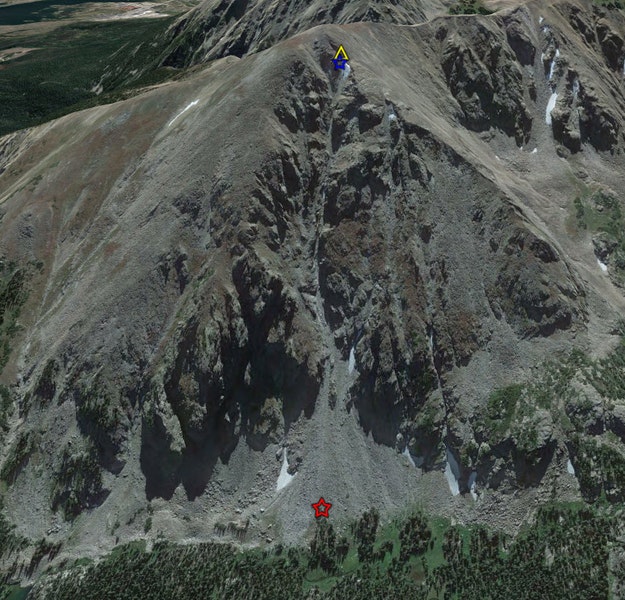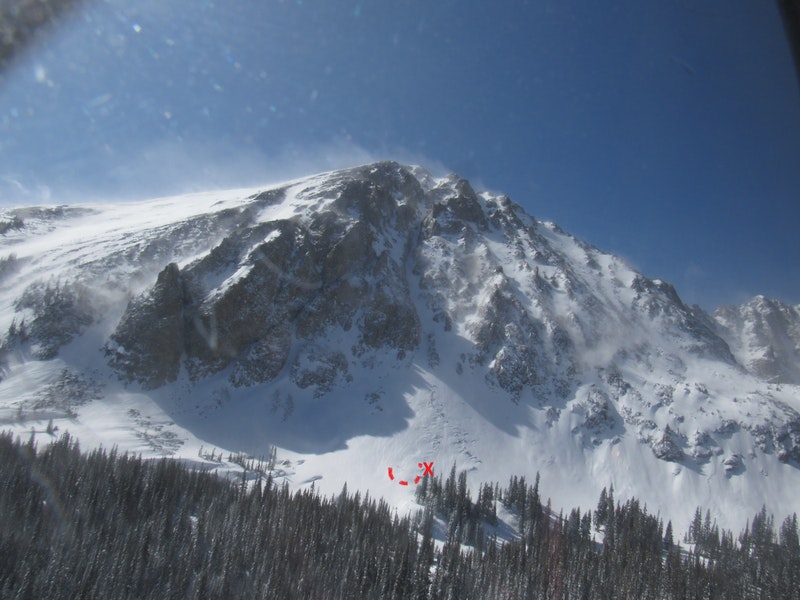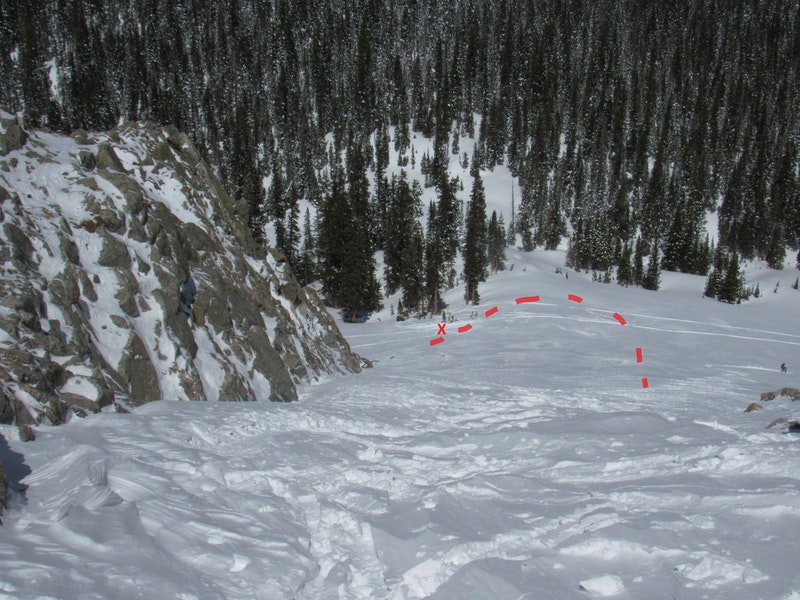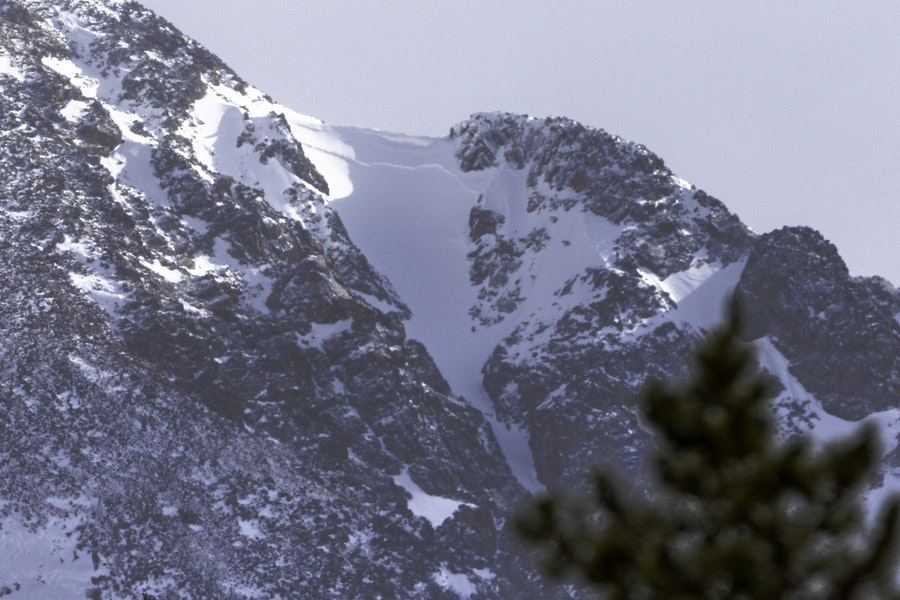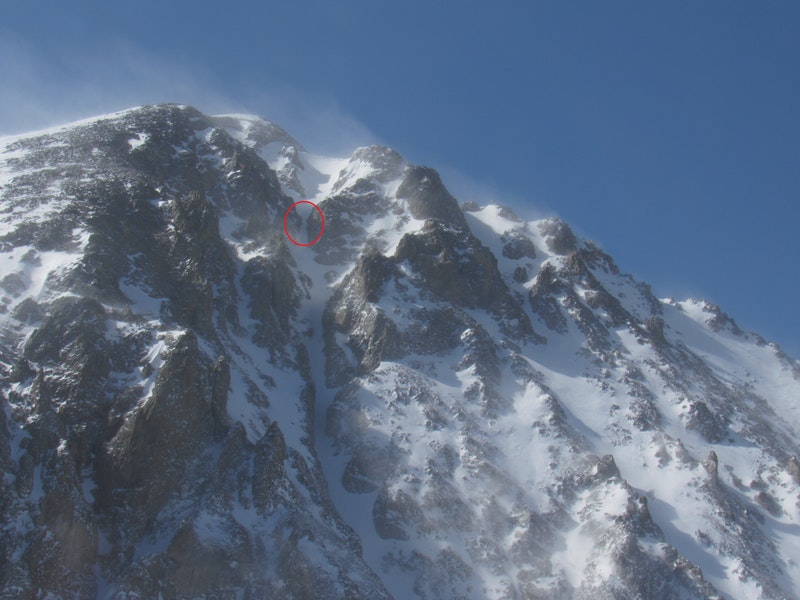
The CAIC just published a final report for the April 15 avalanche that caught two backcountry tourers on Red Peak in Colorado’s Gore Range, killing one of them.
“On April 15, a group of backcountry tourers were involved in an avalanche near Red Peak in the Gore Range. Two riders were caught. The avalanche swept one rider the length of the couloir. He did not survive. Our deepest condolences go out to the family, friends, and everyone affected by this accident.” — CAIC
The full report is attached below and can be viewed HERE.
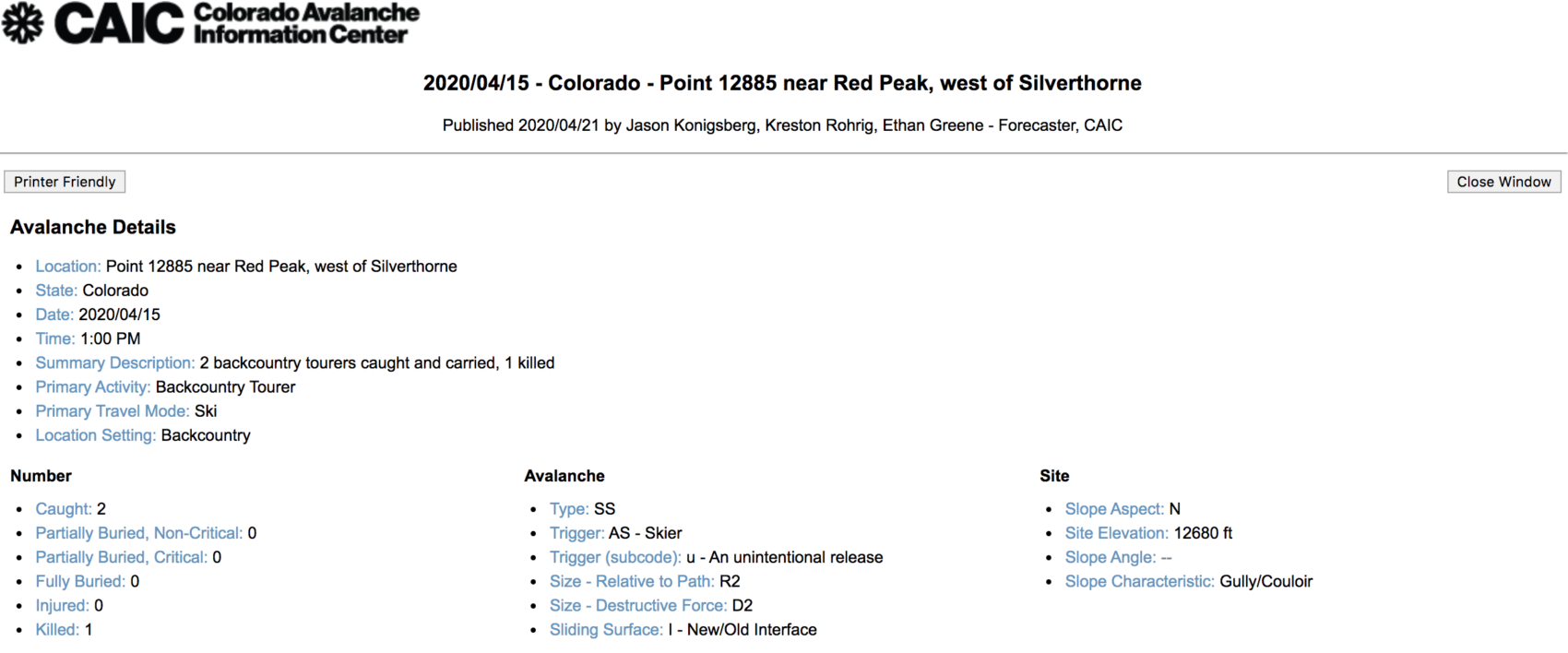
Avalanche Comments
This was a skier-triggered, soft slab avalanche, that broke at the interface of the new snow and old snow layers. CAIC investigators did not visit the start zone of the avalanche, due to the location and a winter storm that impacted the area on the day following the accident. This made it difficult to classify the avalanche size. From the available data, the avalanche appears to be small relative to the path and large enough to kill a person (SS-ASu-R2-D2-I). This was a small D-size 2 avalanche. The path of the avalanche, carrying the skier 1600 feet down a rock-walled couloir, was a significant factor in the outcome of the accident.
Backcountry Avalanche Forecast
The regional backcountry avalanche forecast for the Northern Mountains, issued on the afternoon of April 14, rated the avalanche danger on April 15 as Moderate (Level 2). The Highlights read:
The primary concern is triggering avalanches in freshly wind-drifted snow. The Northern Mountains picked up some decent snowfall over the last couple days, and more is on the way for Wednesday. Winds are strong enough to drift this snow into stiffer slabs up to 2 feet thick in areas that picked up more than foot of recent storm snow. The most dangerous slopes are at higher elevations, steeper than about 35 degrees, and face north and east. Look for signs of recent wind loading like smooth rounded pillows, and slopes below fresh cornice formation. Cracking in the new snow is a clear sign of slab formation.
Weather Summary
After a small storm on April 3, the weather became spring-like. Clear skies, warm daytime temperatures, and nights below freezing were the dominant weather features through April 11. The first in a series of storms arrived in Colorado on April 12. The Copper Mountain SNOTEL site, located at an elevation of 10,550 feet and approximately 10 miles south of the accident site, recorded a 0.5 inch increase in snow water equivalent (SWE) on April 12 with approximately 6 inches of snow. Light snow, windy conditions, and cold temperatures continued through the morning of April 15, with an additional 0.5 inch of SWE and about 6 inches of snow accumulation at the Copper Mountain SNOTEL site. The day of the accident the air temperature was 5 F at the Arapahoe Basin Summit weather station, located at 12,462 feet (a similar elevation to the top of the couloir in the accident) and 15 miles east of the accident site. For the 12 hours prior to the accident, winds were out of the west with sustained speeds between 20 to 25 mph and gusts between 30 to 40 mph.
Snowpack Summary
The total snow water equivalent of the snowpack in Summit County was near median (1981-2010) on April 15. Basal weak layers plagued the snowpack for the majority of the winter, but few avalanches broke on these layers at the end of March and into April. Avalanche problems in April were generally upper-snowpack issues and related to new snow.
A melt-freeze cycle and windy conditions in early April made for a hard and icy surface on many slopes. The icy surface was either the result of a melt-freeze cycle on sunny aspects or wind-packed snow on shady alpine slopes. Thick slabs of snow formed on top of these icy surfaces when snowfall returned to the area on April 12.
Events Leading to the Avalanche
Skiers 1, 2, and 3 met at the Willow Creek trailhead about 8:00 AM on the morning of April 15. Their plan was to ascend to point 12885, northeast of Red Peak, and descend a north-facing couloir locally known as Oh What Big Eyes You Have. Skier 1 had skied the route several times before. It was Skier 2 and 3’s first trip to this area. Skier 2 had skied extensively on Buffalo Peak, the next peak south of Red Peak.
The group climbed up Willow Creek and then ascended southeast facing slopes to the summit of point 12885. They stopped near treeline to jump on a small test slope, but observed no signs of instability. They reached the summit and descended north to the top of the couloir. There are two entrances into the couloir. It was windy and cold while the group discussed their options and examined both entrances. They decided on the western entrance to the couloir. They collected on the skier’s right side of the entrance and prepared for their descent. The wind limited their visibility and verbal communication. They decided to descend into the couloir one at a time and regroup.
Skier 1 carefully entered the couloir. The group was worried about firm slabs of wind-drifted snow. Skier 1 jumped up and down on the snow. The snow was soft. He made a short slope cut across the skier’s right side of the slope. He called up to his friends telling them the wind was calm within the couloir; then descended to a break in the cliff wall on the skier’s right side of the couloir. Skier 2 followed Skier 1’s path and the two of them waited below a rock outcrop.
Accident Summary
Skier 3 waited a few minutes and then followed the same path as Skiers 1 and 2. As Skier 3 descended he triggered a small avalanche. The slide broke below his skis, 8 to 10 inches deep and about 100 feet wide across the top of the couloir. It ran down the couloir and knocked Skiers 1 and 2 from their position. Skier 2 was carried about 70 feet down the couloir. He came to rest with his ski tips resting on the rock wall on the skier’s left side of the couloir.
Rescue Summary
Skier 3 made voice contact with Skier 2 and skied down to him. He passed the area where Skiers 1 and 2 had regrouped. Skier 2 was uninjured. They called for Skier 1 with no response. They knew Skier 1 was not above them, so they descended the couloir in short pitches. They looked for Skier 1 and called out for him as they descended. They reached the bottom of the couloir and turned their avalanche transceivers to search. After several switchbacks they picked up the signal from Skier 1’s transceiver and quickly moved to his position. He was on the snow surface, but covered with a small amount of snow. He did not survive the avalanche.
They pressed the SOS button on their inReach device. They had limited cell phone service, but made a short phone call and communicated with Search and Rescue via text message. Due to weather conditions, time of day, and Skier 1’s condition, they decided to leave him in place and travel out to meet the rescuers. Summit County Rescue Group, Summit County Sheriff’s Office, and Flight for Life retrieved Skier 1’s body on April 17.
Comments
Traveling in steep, rocky, snow-covered terrain always comes with a high degree of risk. The environment tends to amplify events, and sometimes small missteps can have big consequences. In this accident, a relatively small avalanche led to a tragic outcome. Two skiers were caught in the same slide. One was carried a short distance and was uninjured. The other was carried much further and sustained fatal injuries. Even the length and path of the fall may not separate minor and tragic outcomes, as illustrated by a 2017 report of an avalanche that swept a rider through the whole couloir but left him with only minor injuries.
The weather for several days before the accident included small amounts of new snow and 20 to 30 mph winds. These are ideal conditions for wind loading. Even small amounts of new snow spread over the mountains provides plenty of snow for transport. Winds stronger than about 10 mph will build drifts on the lee side of ridges and terrain features. Winds stronger than 40 or 50 mph tend to blow snow further down the hillside or completely away. In this case, the new wind drifts were resting on the old, icy snow surface. This is a good recipe for a Wind Slab avalanche. The best time to trigger an avalanche like this is during, or shortly after, the loading event. This is not a usual spring-time scenario in Colorado. Clear skies and warm days create a firm snow surface followed by a snowstorm. Spring-like conditions quickly turn back to winter-like conditions, where it is easy to trigger a small slab avalanche that breaks at the interface of the old and new snow layers. Small avalanches might not be that dangerous in low-consequence terrain, but can be deadly if they push you over a cliff, into trees or rocks, or take you for a long ride.
Photos
